2.3 – Staining Microscopic Specimens
Learning Objectives
- Differentiate between simple and differential stains
- Describe the unique features of commonly used stains
- Explain the procedures and name clinical applications for Gram, endospore, acid-fast, negative capsule, and flagella staining
In their natural state, most of the cells and microorganisms that we observe under the microscope lack color and contrast. This makes it difficult, if not impossible, to detect important cellular structures and their distinguishing characteristics without artificially treating specimens. We have already alluded to certain techniques involving stains and fluorescent dyes, and in this section we will discuss specific techniques for sample preparation in greater detail. Indeed, numerous methods have been developed to identify specific microbes, cellular structures, D.N.A. sequences, or indicators of infection in tissue samples, under the microscope. Here, we will focus on the most clinically relevant techniques.
Preparing Specimens for Light Microscopy
In clinical settings, light microscopes are the most commonly used microscopes. There are two basic types of preparation used to view specimens with a light microscope: wet mounts and fixed specimens.
The simplest type of preparation is the wet mount, in which the specimen is placed on the slide in a drop of liquid. Some specimens, such as a drop of urine, are already in a liquid form and can be deposited on the slide using a dropper. Solid specimens, such as a skin scraping, can be placed on the slide before adding a drop of liquid to prepare the wet mount. Sometimes the liquid used is simply water, but often stains are added to enhance contrast. Once the liquid has been added to the slide, a coverslip is placed on top and the specimen is ready for examination under the microscope.
The second method of preparing specimens for light microscopy is fixation. The “fixing” of a sample refers to the process of attaching cells to a slide. Fixation is often achieved either by heating (heat fixing) or chemically treating the specimen. In addition to attaching the specimen to the slide, fixation also kills microorganisms in the specimen, stopping their movement and metabolism while preserving the integrity of their cellular components for observation.
To heat-fix a sample, a thin layer of the specimen is spread on the slide (called a smear), and the slide is then briefly heated over a heat source (Figure 2.31). Chemical fixatives are often preferable to heat for tissue specimens. Chemical agents such as acetic acid, ethanol, methanol, formaldehyde (formalin), and glutaraldehyde can denature proteins, stop biochemical reactions, and stabilize cell structures in tissue samples (Figure 2.31).

In addition to fixation, staining is almost always applied to color certain features of a specimen before examining it under a light microscope. Stains, or dyes, contain salts made up of a positive ion and a negative ion. Depending on the type of dye, the positive or the negative ion may be the chromophore (the colored ion); the other, uncolored ion is called the counterion. If the chromophore is the positively charged ion, the stain is classified as a basic dye; if the negative ion is the chromophore, the stain is considered an acidic dye.
Dyes are selected for staining based on the chemical properties of the dye and the specimen being observed, which determine how the dye will interact with the specimen. In most cases, it is preferable to use a positive stain, a dye that will be absorbed by the cells or organisms being observed, adding color to objects of interest to make them stand out against the background. However, there are scenarios in which it is advantageous to use a negative stain, which is absorbed by the background but not by the cells or organisms in the specimen. Negative staining produces an outline or silhouette of the organisms against a colorful background (Figure 2.32).

Because cells typically have negatively charged cell walls, the positive chromophores in basic dyes tend to stick to the cell walls, making them positive stains. Thus, commonly used basic dyes such as basic fuchsin, crystal violet, malachite green, methylene blue, and safranin typically serve as positive stains. On the other hand, the negatively charged chromophores in acidic dyes are repelled by negatively charged cell walls, making them negative stains. Commonly used acidic dyes include acid fuchsin, eosin, and rose bengal. Figure 2.40 provides more detail.
Some staining techniques involve the application of only one dye to the sample; others require more than one dye. In simple staining, a single dye is used to emphasize particular structures in the specimen. A simple stain will generally make all of the organisms in a sample appear to be the same color, even if the sample contains more than one type of organism. In contrast, differential staining distinguishes organisms based on their interactions with multiple stains. In other words, two organisms in a differentially stained sample may appear to be different colors. Differential staining techniques commonly used in clinical settings include Gram staining, acid-fast staining, endospore staining, flagella staining, and capsule staining. Figure 2.41 provides more detail on these differential staining techniques.
Check Your Understanding
- Explain why it is important to fix a specimen before viewing it under a light microscope.
- What types of specimens should be chemically fixed as opposed to heat-fixed?
- Why might an acidic dye react differently with a given specimen than a basic dye?
- Explain the difference between a positive stain and a negative stain.
- Explain the difference between simple and differential staining.
Gram Staining
The Gram stain procedure is a differential staining procedure that involves multiple steps. It was developed by Danish microbiologist Hans Christian Gram in 1884 as an effective method to distinguish between bacteria with different types of cell walls, and even today it remains one of the most frequently used staining techniques. The steps of the Gram stain procedure are listed below and illustrated in Figure 2.33.
-First, crystal violet, a primary stain, is applied to a heat-fixed smear, giving all of the cells a purple color.
-Next, Gram’s iodine, a mordant, is added. A mordant is a substance used to set or stabilize stains or dyes; in this case, Gram’s iodine acts like a trapping agent that complexes with the crystal violet, making the crystal violet–iodine complex clump and stay contained in thick layers of peptidoglycan in the cell walls.
-Next, a decolorizing agent is added, usually ethanol or an acetone/ethanol solution. Cells that have thick peptidoglycan layers in their cell walls are much less affected by the decolorizing agent; they generally retain the crystal violet dye and remain purple. However, the decolorizing agent more easily washes the dye out of cells with thinner peptidoglycan layers, making them again colorless.
-Finally, a secondary counterstain, usually safranin, is added. This stains the decolorized cells pink and is less noticeable in the cells that still contain the crystal violet dye.
A table shows the Gram stain process. Each row consists of a column describing the step and a column describing the effect. Additional columns show drawings to support the description in the effects column. Step 1: Crystal Violet, the primary stain, is added to the specimen smear. This stains cells purple or blue. The Gram-positive and Gram-negative cells all look purple. Step 2: Iodine, the mordant, makes the dye less soluble so it adheres to cell walls. The cells remain purple or blue. The Gram-positive and Gram-negative cells all look purple. Step 3: Alcohol, the decolorizer, washes away stain from Gram-negative cell walls. Gram-positive cells remain purple or blue, Gram-negative cells are colorless. Step 4: Safranin, the counterstain, allows dye adherence to Gram-negative cells. Gram-positive cells remain a pruple or blue. Gram-negative cells appear pink or red.
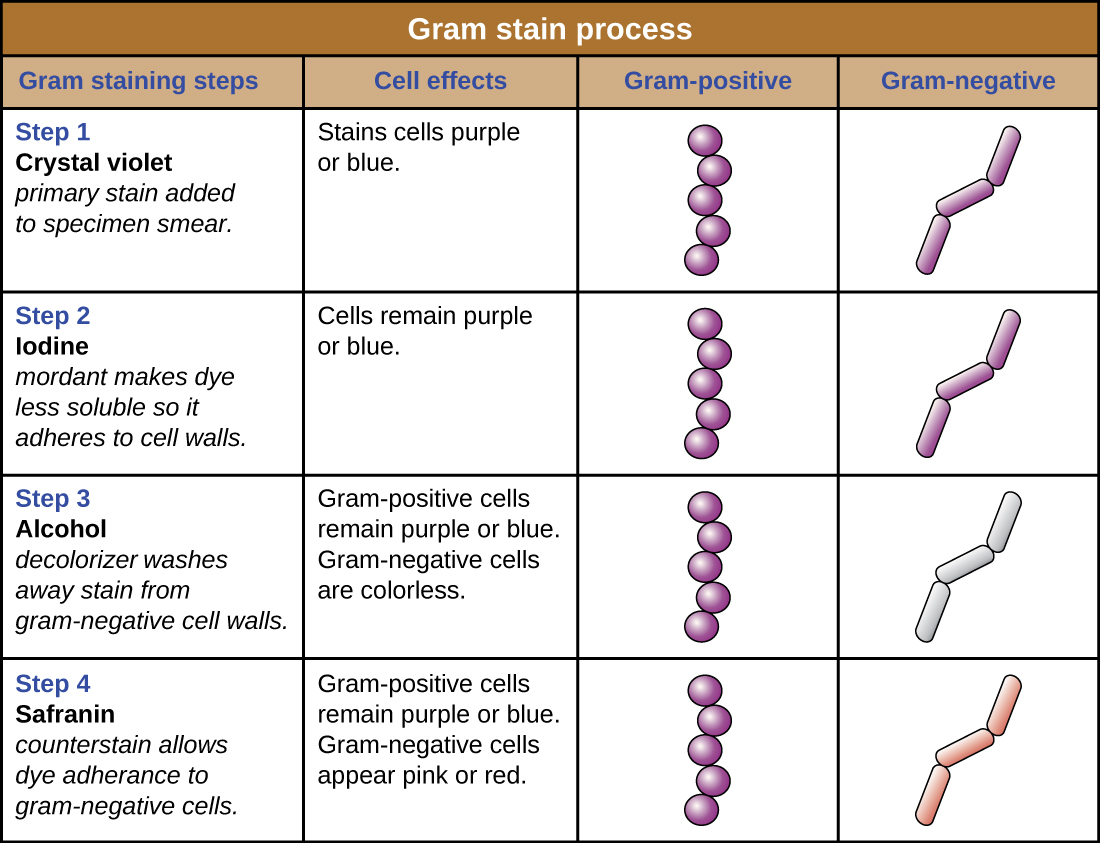
The purple, crystal-violet stained cells are referred to as gram-positive cells, while the red, safranin-dyed cells are gram-negative (Figure 2.34). However, there are several important considerations in interpreting the results of a Gram stain. First, older bacterial cells may have damage to their cell walls that causes them to appear gram-negative even if the species is gram-positive. Thus, it is best to use fresh bacterial cultures for Gram staining. Second, errors such as leaving on decolorizer too long can affect the results. In some cases, most cells will appear gram-positive while a few appear gram-negative (as in Figure 2.34). This suggests damage to the individual cells or that decolorizer was left on for too long; the cells should still be classified as gram-positive if they are all the same species rather than a mixed culture.
Besides their differing interactions with dyes and decolorizing agents, the chemical differences between gram-positive and gram-negative cells have other implications with clinical relevance. For example, Gram staining can help clinicians classify bacterial pathogens in a sample into categories associated with specific properties. Gram-negative bacteria tend to be more resistant to certain antibiotics than gram-positive bacteria. We will discuss this and other applications of Gram staining in more detail in later chapters.

Check Your Understanding
- Explain the role of Gram’s iodine in the Gram stain procedure.
- Explain the role of alcohol in the Gram stain procedure.
- What color are gram-positive and gram-negative cells, respectively, after the Gram stain procedure?
Acid-Fast Stains
Acid-fast staining is another commonly used, differential staining technique that can be an important diagnostic tool. An acid-fast stain is able to differentiate two types of gram-positive cells: those that have waxy mycolic acids in their cell walls, and those that do not. Two different methods for acid-fast staining are the Ziehl-Neelsen technique and the Kinyoun technique. Both use carbolfuchsin as the primary stain. The waxy, acid-fast cells retain the carbolfuchsin even after a decolorizing agent (an acid-alcohol solution) is applied. A secondary counterstain, methylene blue, is then applied, which renders non–acid-fast cells blue.
The fundamental difference between the two carbolfuchsin-based methods is whether heat is used during the primary staining process. The Ziehl-Neelsen method uses heat to infuse the carbolfuchsin into the acid-fast cells, whereas the Kinyoun method does not use heat. Both techniques are important diagnostic tools because a number of specific diseases are caused by acid-fast bacteria (A.F.B.). If A.F.B. are present in a tissue sample, their red or pink color can be seen clearly against the blue background of the surrounding tissue cells (Figure 2.36).
Check Your Understanding
- Why are acid-fast stains useful?
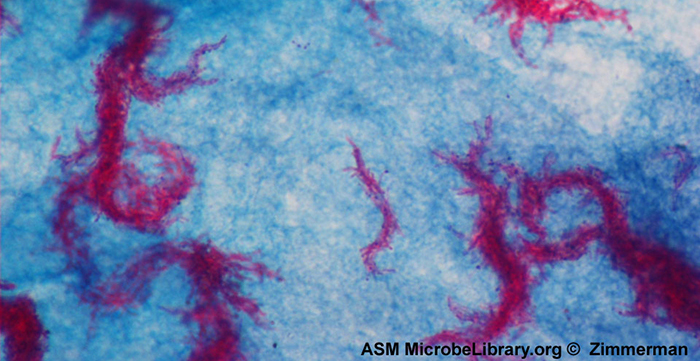
Capsule Staining
Certain bacteria and yeasts have a protective outer structure called a capsule. Since the presence of a capsule is directly related to a microbe’s virulence (its ability to cause disease), the ability to determine whether cells in a sample have capsules is an important diagnostic tool. Capsules do not absorb most basic dyes; therefore, a negative staining technique (staining around the cells) is typically used for capsule staining. The dye stains the background but does not penetrate the capsules, which appear like halos around the borders of the cell. The specimen does not need to be heat-fixed prior to negative staining.
One common negative staining technique for identifying encapsulated yeast and bacteria is to add a few drops of India ink or nigrosin to a specimen. Other capsular stains can also be used to negatively stain encapsulated cells (Figure 2.37). Alternatively, positive and negative staining techniques can be combined to visualize capsules: The positive stain colors the body of the cell, and the negative stain colors the background but not the capsule, leaving halo around each cell.

Check Your Understanding
- How does negative staining help us visualize capsules?
Endospore Staining
Endospores are structures produced within certain bacterial cells that allow them to survive harsh conditions. Gram staining alone cannot be used to visualize endospores, which appear clear when Gram-stained cells are viewed. Endospore staining uses two stains to differentiate endospores from the rest of the cell. The Schaeffer-Fulton method (the most commonly used endospore-staining technique) uses heat to push the primary stain (malachite green) into the endospore. Washing with water decolorizes the cell, but the endospore retains the green stain. The cell is then counterstained pink with safranin. The resulting image reveals the shape and location of endospores, if they are present. The green endospores will appear either within the pink vegetative cells or as separate from the pink cells altogether. If no endospores are present, then only the pink vegetative cells will be visible (Figure 2.38).
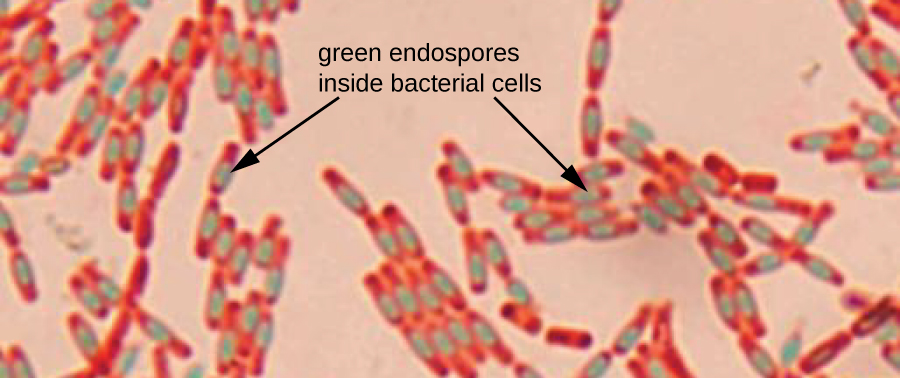
Endospore-staining techniques are important for identifying Bacillus and Clostridium, two genera of endospore-producing bacteria that contain clinically significant species. Among others, B. anthracis (which causes anthrax) has been of particular interest because of concern that its spores could be used as a bioterrorism agent. C. difficile is a particularly important species responsible for the typically hospital-acquired infection known as “C. diff.”
Check Your Understanding
- Is endospore staining an example of positive, negative, or differential staining?
Flagella Staining
Flagella (singular: flagellum) are tail-like cellular structures used for locomotion by some bacteria, archaea, and eukaryotes. Because they are so thin, flagella typically cannot be seen under a light microscope without a specialized flagella staining technique. Flagella staining thickens the flagella by first applying mordant (generally tannic acid, but sometimes potassium alum), which coats the flagella; then the specimen is stained with pararosaniline (most commonly) or basic fuchsin (Figure 2.39).
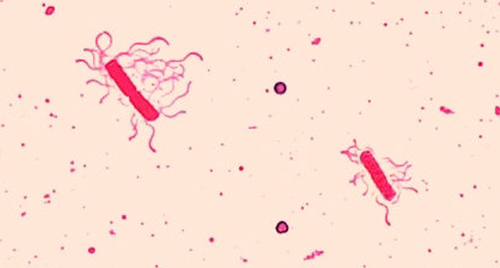
Though flagella staining is uncommon in clinical settings, the technique is commonly used by microbiologists, since the location and number of flagella can be useful in classifying and identifying bacteria in a sample. When using this technique, it is important to handle the specimen with great care; flagella are delicate structures that can easily be damaged or pulled off, compromising attempts to accurately locate and count the number of flagella.
A table of simple stains is shown. Basic stains include: methylene blue, crystal violet, malachite green, basic fuschsin, carbolfuschsin, and safranin. Basic stains stain negatively charged molecules and structures, such as nucleic acids and proteins. The outcome of this positive stain is dark cells on a light background. Acidic stains include eosine, acid fuchsin, rose Bengal, and Congo red. Acid stains stain positively charged molecules and structures such as proteins. Acidic stains can either be positive or negative stains depending on the cell’s chemistry. Negative stains include india in k and nigrosine. Negative stains stain the background, not the specimen and produce a dark background with a light specimen.
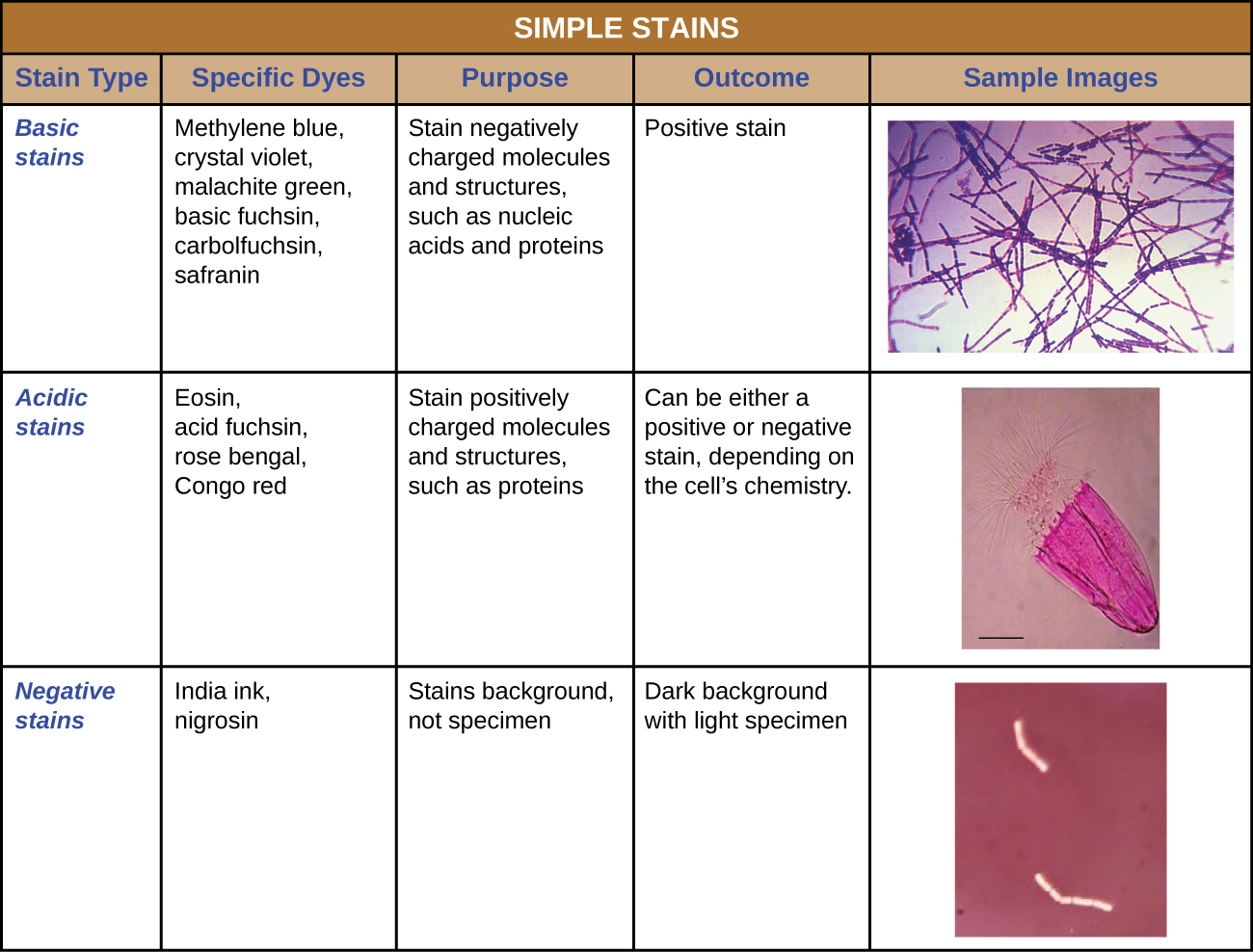
A table of differential stains is shown. The Gram stain uses crystal violet, Gram’s iodine, ethanol (decolorizer), and safranin. The purpose of the Gram stain is to distinguish cells by cell-wall type (Gram-positive, Gram-negative). Gram-positive cells stain purple/violet. Gram-negative cells stain pink. The acid fast stain: after staining with basic fuchsin, acid-fast bacteria resist decolonization by acid-alcohol. Non-acid-fast bacteria are counterstained with methylene blue. The acid-fast stain is used to distinguish acid-fast bacteria such as M. tuberculosis, from non-acid-fast cells. Acid-fast bacteria are red; non-acid-fast cells are blue. The Endospore stain uses heat to stain endospores with malachite green (Schaeffer-Fulton procedure), then cell is washed and counterstained with safranin. The endospore stain is used to distinguish organisms with endospores from those without; used to study the endospore. Endospores appear bluish-green; other structures appear pink to red. Flagella stain: flagella are coated with a tannic acid or potassium alum mordant, then stained using either pararosaline or basic fuchsin. The flagella stain is used to view and study flagella in bacteria that have them. Flagella are visible as thin strands if present. Capsule stain: negative staining with india ink or nigrosine is used to stain the background, leaving a clear area of the cell and the capsule Counterstaining can be used to stain the cell while leaving the capsule clear. The capsule stain is used to distinguish cells with capsules from those without. Capsules appear clear or as halos if present.
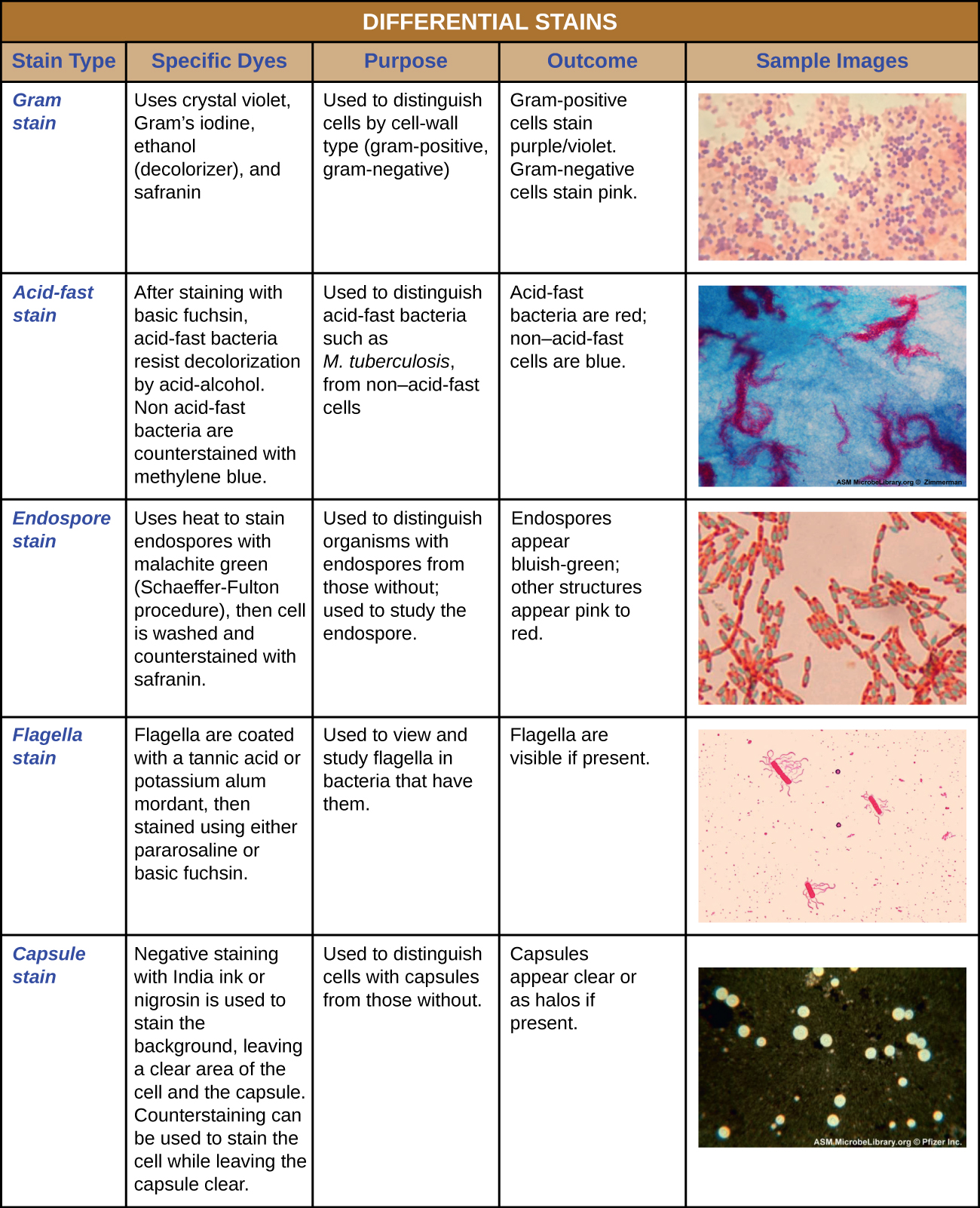
Check Your Understanding
- What is the main difference between preparing a sample for fluorescence microscopy versus light microscopy?
Link to Learning
Cornell University’s Case Studies in Microscopy offers a series of clinical problems based on real-life events. Each case study walks you through a clinical problem using appropriate techniques in microscopy at each step
Section Concepts Summary
- Samples must be properly prepared for microscopy. This may involve staining, fixation, and/or cutting thin sections.
- A variety of staining techniques can be used with light microscopy, including Gram staining, acid-fast staining, capsule staining, endospore staining, and flagella staining.
- Samples for T.E.M. require very thin sections, whereas samples for S.E.M. require sputter-coating.
- Preparation for fluorescence microscopy is similar to that for light microscopy, except that fluorochromes are used.

